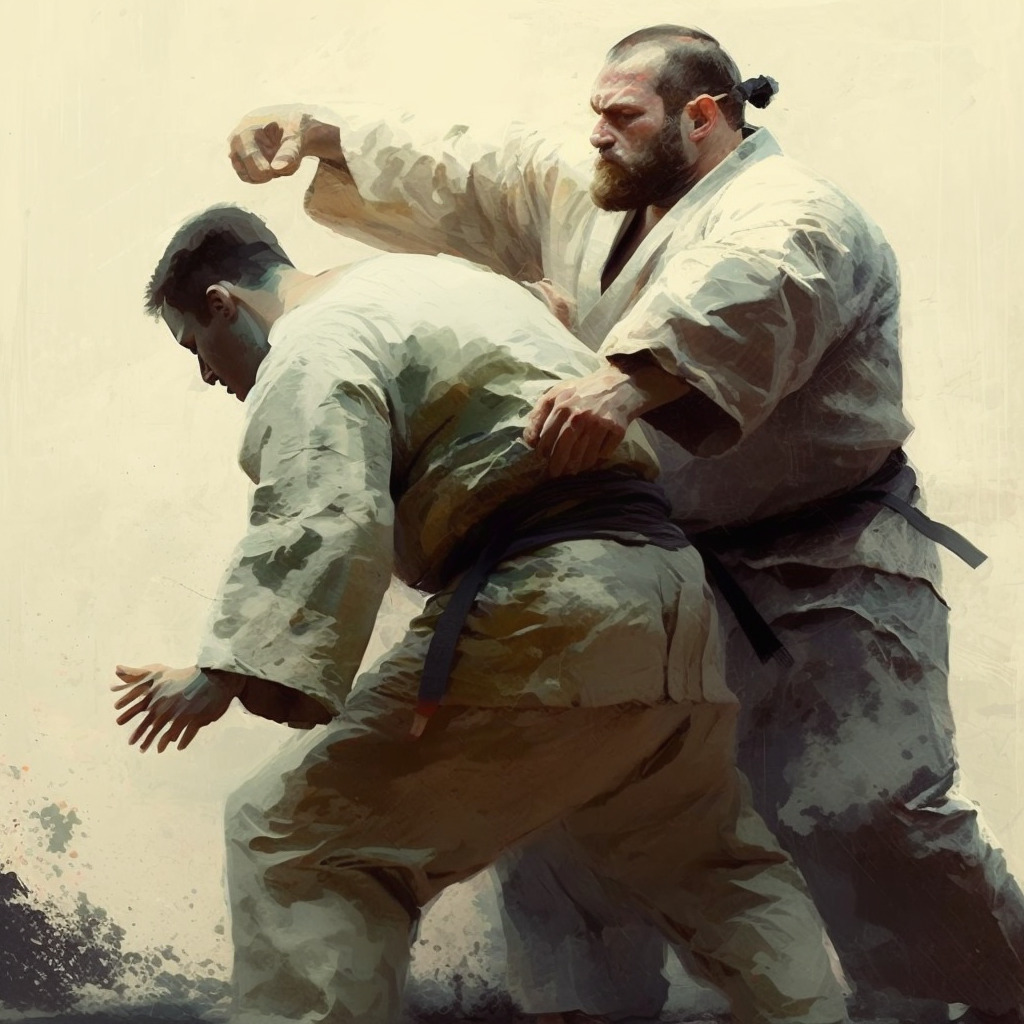Beim Judo Training muss man dabei sein, um es zu fühlen und wirklich für sich gewinnen zu können. Dennoch versuchen wir euch ein paar typische Trainingseinheiten vorzustellen. Das Training ist nicht nur förderlich für die Fitness, sondern hilft auch die Techniken und Bewegungsabläufe zu erlernen. Manche Übungen lassen sich auch zuhause üben – wir verraten welche sich dafür eignen.
Eine typische Judo Trainingsstunde
Im Folgenden versuchen wir euch eine typisches Judo Training vorzustellen. Sicherlich setzen Trainer andere Schwerpunkte, der Ablauf ist jedoch meist sehr ähnlich. Am besten besucht ihr mal eine Trainingsstunde bei einem Judoverein in eurer Nähe. In aller Regel ist das Zuschauen oder eine einmalige Teilnahme umsonst und bietet euch einen noch besseren Einblick.
| 1. Die Begrüßung | Beim Betreten des Dojos ist es üblich, an der Türschwelle anzuhalten und sich in Richtung der Hallenmitte zu verneigen. Das eigentliche Judo Training wird anschließend mit einer Begrüßung gestartet.
Hierbei stellen sich die Schüler nach ihrem Rang in einer Reihe auf und beginnen vom erfahrensten auf der rechten Seite bis zum Neuling auf der Linken. Auf Befehl des Sensei wird sich erst verbeugt, danach gesetzt und konzentriert, dann mit einer tiefen Verbeugung begrüßt, bei der die Stirn fast den Boden berührt und danach wieder erhoben. Abschließend folgt noch eine stehende Verbeugung. Diese traditionelle Prozedur ist bei vielen japanischen Kampfsportarten anzutreffen und zeigt höchsten Respekt vor dem Sensei, dem Dojo und allen sonstigen Anwesenden, Schülern wie Lehrern. |
| 2. Die Aufwärmphase | Nach der Begrüßung folgt das Aufwärmen, was meist in Form von verschiedenen Laufübungen, wie zum Beispiel Kniehebelauf oder Seitschritten, vollzogen wird. Manche Trainer bringen spielerische Elemente wie etwa Ballsportarten mit in die Aufwärmphase ein, um den Spaßfaktor zu erhöhen. Ein paar kurze Dehnübungen runden diese erste Phase des Trainings ab und geben Euch Zeit zum Durchatmen. |
| 3. Technik Übungen | Dann folgt der Technikteil, in welchem das Augenmerk auf die Perfektion der einzelnen Bewegungsabläufe gelegt werden soll. Hier werden beispielsweise Fallübungen gemacht oder neue Judo Techniken unter dem wachsamen Auge des Trainers erlernt und einstudiert. Der Sinn in diesem Teil des Trainings ist die bessere Beherrschung der Judo Techniken und weniger deren praktische Anwendung. |
| 4. Randori (Übungskampf) | Anschließend werden beim Randori die gelernten Hebel und Würfe mit einem Übungspartner trainiert. Randori soll einen Übungskampf in lockerer Atmosphäre darstellen, bei dem es weder Gewinner noch Verlierer gibt. Lediglich die korrekte Anwendung der erlernten Techniken an einem Gegner, welcher sich auch verteidigt und seinerseits Techniken anwendet, steht im Mittelpunkt. Sollten einige Kyú eine Gürtelprüfung mit einer Kata vor sich haben, so wird sie auch in diesem Trainingsabschnitt mit geübt. |
| 5. Die Verabschiedung | Abschließend folgt die Verabschiedung, die mit der Begrüßung identisch ist. Beim Verlassen des Dojos wird sich ebenfalls auf der Türschwelle noch einmal in Richtung Hallenmitte verneigt. |
Das folgende Video bietet ebenfalls einen guten Einblick in eine Judo Trainingseinheit. Das Video geht zwar nur etwas mehr als 10 Minuten, das Training reicht aber für 2 Stunden aus. Es beinhaltet Warm up, Fallschule, Einwerfen, Standtechniken und Randori als Übungsform.
Wie viel Fitness muss man für Judo aufbringen?
Letztlich ist diese Frage einfach beantwortet: sehr viel. Die körperliche Anstrengung, die Euch eine zweistündige Trainingseinheit abverlangt, ist enorm. Besonders im späteren Verlauf des Trainings, also bei den höheren Kyú und Dan Prüfungen und deren Vorbereitung, werdet Ihr die Grenzen Eurer körperlichen Leistungsfähigkeit neu kennen lernen.
Aber nur keine Angst: der Sensei und die anderen Judoka werden Euch Schritt für Schritt an diese Aufgaben heranführen und Eure Fitness steigt ja ohnehin stetig an, sofern Ihr fleißig das Training besucht.

Wie lange dauert es, Judo zu erlernen?
Auf die Frage hin, wie lange es dauert, bis man Judo beherrscht, antworten die großen Meister sehr gern: “Ewig, denn man lernt nie aus.” Das ist der Wahrheit gar nicht einmal so fern, auch wenn “ewig” für den Neuling immer eine etwas abschreckende Zeitangabe darstellt. In gewisser Weise haben sie aber Recht, denn Judo lernen ist keine Aufgabe, die Ihr mal eben schnell erledigen könnt. Daher ist es auch nicht unüblich, dass Judo für Kinder angeboten wird. So werden sie bereits früh an die Bewegungsabläufe und Techniken herangeführt.
Übung macht den Meister, das gilt auch beim Judo. Es gibt keinen Judo Kurs „Judo für Anfänger“, wo Euch ein Lehrer in einem 14-tägigen Crashkurs alles beibringt, was Ihr wissen müsst.
In der Regel dauert es, je nach Fitnessgrad bei Trainingsbeginn, zwischen drei und sechs Monaten, bis Ihr alle Benimmregeln verinnerlicht habt und Euer Körper damit beginnt, sich dem Leistungsniveau der Gruppe zu nähern. Manche von Euch haben nach dieser Zeit auch schon die erste Prüfung hinter sich, aber andere benötigen diese Zeit, damit sich Euer Körper auf diese Herausforderung einstellen kann. Sobald Ihr Eure Kräfte so einteilen könnt, dass Ihr die Trainingseinheit vollständig durchziehen könnt, werdet Ihr auch schnell erste Erfolge verzeichnen können.
Wenn Ihr dann erst einmal den nächsten Judogürtel in Händen haltet, werdet Ihr auch verstehen, warum die großen Meister nie mit dem Judo lernen aufhören. Es gibt immer eine noch größere Herausforderung zu bewältigen.
- Boxsack Basics: Findet den perfekten Boxsack für euer Heimtraining - 23. November 2023
- Mobbing am Arbeitsplatz: Tipps & Hilfestellungen für Betroffene - 15. November 2023
- Wohnung & Haus effektiv vor Einbruch schützen: 10 Tipps & FAQ - 3. November 2023
Update: 2025-06-30 / Affiliate Links / Bilder von der Amazon Product Advertising API

